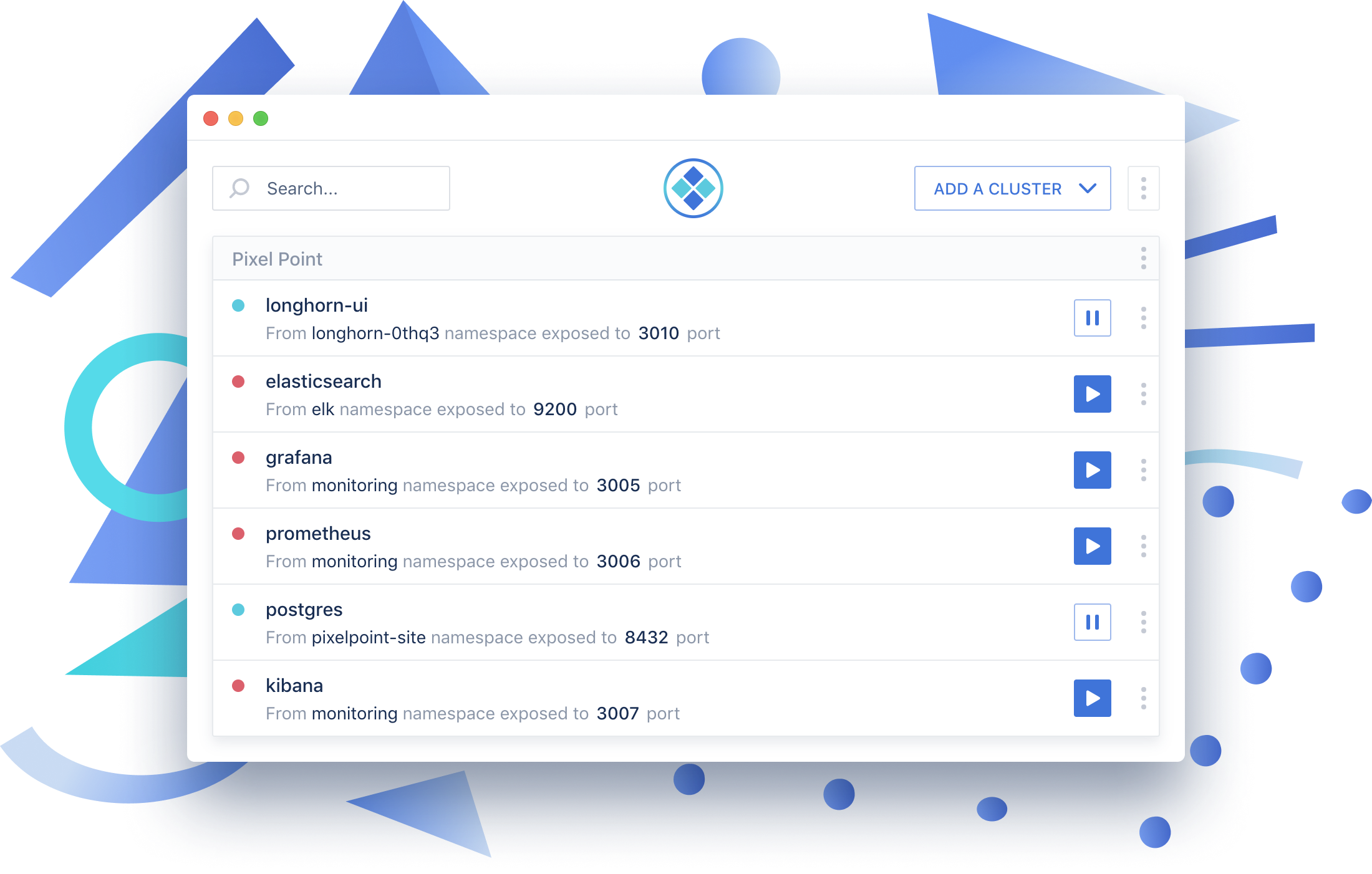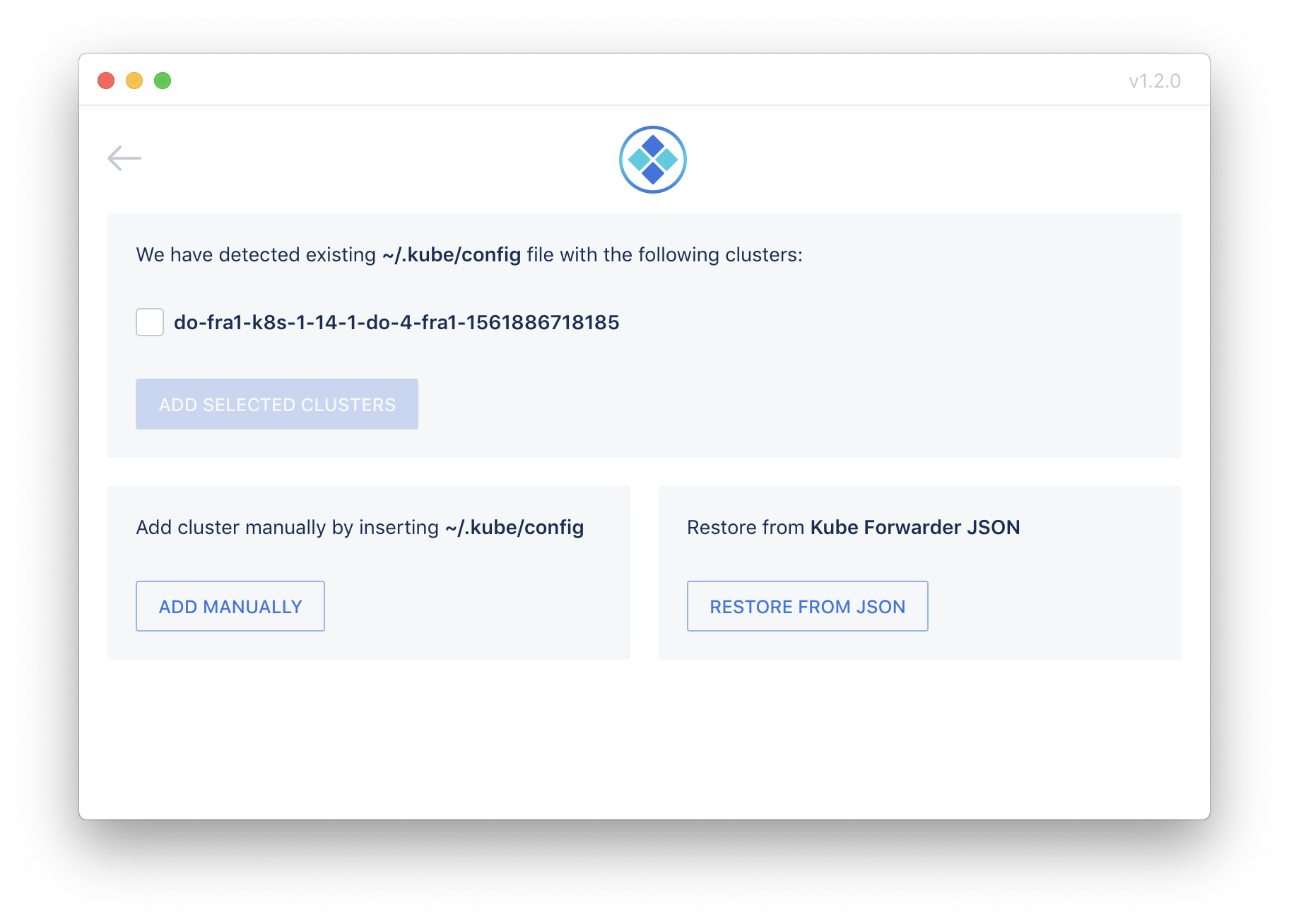https://github.com/pixel-point/kube-forwarder
Easy to use Kubernetes port forwarding manager
https://github.com/pixel-point/kube-forwarder
devops electron k8s kubernetes linux macos port-forwarding vue windows
Last synced: about 2 months ago
JSON representation
Easy to use Kubernetes port forwarding manager
- Host: GitHub
- URL: https://github.com/pixel-point/kube-forwarder
- Owner: pixel-point
- License: mit
- Created: 2019-05-26T19:56:12.000Z (about 6 years ago)
- Default Branch: master
- Last Pushed: 2024-05-11T02:01:35.000Z (about 1 year ago)
- Last Synced: 2024-11-25T15:52:29.608Z (8 months ago)
- Topics: devops, electron, k8s, kubernetes, linux, macos, port-forwarding, vue, windows
- Language: Vue
- Homepage: https://kube-forwarder.pixelpoint.io/
- Size: 792 KB
- Stars: 1,095
- Watchers: 15
- Forks: 187
- Open Issues: 67
-
Metadata Files:
- Readme: README.md
- License: LICENSE.md
- Code of conduct: .github/CODE_OF_CONDUCT.md
Awesome Lists containing this project
README
Kube Forwarder
Easy to use Kubernetes port forwarding manager
Visit a Website ·
Download for macOS ·
Download for Windows ·
Download for Linux
·
Install with Homebrew

## Features
**Auto-reconnect**
Kube Forwarder watches for connection status and always tries reconnect on failure
**Multiple clusters support**
Bookmark and forward Kubernetes services from multiple clusters easily like never before
**Share bookmarks**
Use import and export functionality to share bookmarked services with your team or simply backup it
**Zero native dependencies**
Use port-forwarding without installing kubectl and avoid explanations to developers on how to use it
## Optional dependencies
* [Google Cloud SDK](https://cloud.google.com/sdk/)
* [AWS CLI](https://docs.aws.amazon.com/cli/)
## Functionality walk-through
### Add a cluster(s)
Before you start forwarding internal resources to your local machine, you have to add cluster configuration.
To do this we have 3 different options in the app:
1) Auto-detection of ~/.kube/config file and parsing settings from it
1) Manual adding of Kubernetes config by selecting a file(s)
1) Manual adding of Kubernetes config by pasting a text
1) Import of the JSON file that could be generated via Kube Forwarder export functionality
When you add a new cluster via auto-detection (option 1) or manually using a file(a) selection (option 2), we could parse
configs and if there are multiple contexts inside we will suggest you to add multiple clusters to the app.
Few examples of yaml files we expect to have you could find [there](https://github.com/pixel-point/kube-forwarder/issues/7)
Also, you could add a cluster by filling a form manually (option 3). The form has the following fields:
* Name - the name of a cluster withing Kube Forwarder app.
* Storing method (Set destination to your kube config or paste it as a text) - the method of storing a config It has two options:
* `Set a path` - storing a path to the config file. It will be read every time when you forwarding a port. It allows
a user to don't do any changes in Kube Forwarder's settings when a third-party app updates the config file.
For example, when `azure-cli` updates an access token (#13).
* `Paste as a text` - storing a config just as a yml text.
* Path (if storing method is `Set a path`) - the path to a config file.
* Content (if storing method is `Paste as a text`) - Yml config as a text.
* Current Context (if storing method is `Set a path`) - When you use `Set a path`, you must select a context from a file
which will be used to connect to a resource. Let's see an example of a problem that the field solves.
1) Let's say we don't have `Current context` field.
1) A user has a config file with two contexts: `local-cluster` and `remote-cluster`.
`current-context` in the yml file is `local-cluster`.
1) The user configured a cluster in Kube Forwarder with `Set a path` option.
1) The user created a resource `postgres` and successfully forwarded ports for some time.
1) Then the user executed `kubectl config use-context remote-cluster`
1) If the user tries to forward the resource in Kube Forwarder again, most likely there will be an error
since a connection will be established with `remote-cluster`, not `local-cluster` as the user expected,
and `remote-cluster` couldn't have `postgres` resource.
So, to avoid the error we should store the current context in a separate field.
### Add a resource
Kube Forwarder supports forwarding of all types of resources that supported by `kubectl` – Pod, Deployment, Service.
We ask you to fill the form with the following fields:
**Cluster Name** - pick a cluster from one of the added clusters.
**Namespace** - the namespace of the resource you plan to forward.
**Kind** – pick one of the options Pod, Deployment or Service.
**Name** - name of the Pod, Deployment or Service.
**Alias** - alternative name of the resource that will be displayed on the homepage(optional)
**Port Forwarding**
- **Local port** - port from your local machine where the resource will be forwarded. Note that ports <= 1024 are
restricted to user `root`
- **Resource port** - port of the resource from the Kubernetes cluster
**Use Custom Local Address** - Check this and put an IP address or hostname into the text field to
use a different listen address. Putting each service on its own address avoids sharing/collisions between
services on cookies and port number. Specify a loopback address like `127.0.x.x` or add entries to your
hosts file like `127.0.1.1 dashboard.production.kbf` and put the assigned name in this column. If blank or
unchecked, `localhost` / `127.0.0.1` will be used.
### Import/Export
Kube Forwarder allows you export cluster configuration in JSON that you could use to share with your team members or for the backup purpose. You could easily store it on Github. When you export cluster, you could export it with or without confidential information.
### Install with Homebrew
```
brew cask install kube-forwarder
```
## Contributing
We encourage you to contribute to Kube Forwarder!
We expect contributors to abide by our underlying [code of conduct](./.github/CODE_OF_CONDUCT.md).
All conversations and discussions on GitHub (issues, pull requests)
must be respectful and harassment-free.
This project was generated with [electron-vue](https://github.com/SimulatedGREG/electron-vue)@[8fae476](https://github.com/SimulatedGREG/electron-vue/tree/8fae4763e9d225d3691b627e83b9e09b56f6c935) using [vue-cli](https://github.com/vuejs/vue-cli). Documentation about the original structure can be found [here](https://simulatedgreg.gitbooks.io/electron-vue/content/index.html).
### How to contribute
1. Fork the project & clone locally. Follow the initial setup [here](#getting-started).
2. Create a branch, naming it either a feature or bug: `git checkout -b feature/that-new-feature` or `bug/fixing-that-bug`
3. Code and commit your changes. Bonus points if you write a [good commit message](https://chris.beams.io/posts/git-commit/): `git commit -m 'Add some feature'`
4. Push to the branch: `git push origin feature/that-new-feature`
5. Create a pull request for your branch 🎉
## Getting started
### Prerequisites
* Node 10.8+
* MacOS (if you want to build `.dmg` target)
* Docker (if you want to run tests)
* ImageMagick (to build app icon)
### Installing
Fork Kube Forwarder repository (https://github.com/pixel-point/kube-forwarder/fork)
```
# Clone source code
git clone https://github.com//kube-forwarder
# install dependencies
npm install
# prepare .env files
cp .env.example .env
cp .env.example .env.production
# serve with hot reload in Electron Dev app
npm run dev
# serve WEB version with hot reload at localhost:9081
npm run web
```
### Build
Build an application for production
```
# Build a target for current OS
npm run build
# Build a target for Windows
npm run build -- -- --win
# Build a target for Linux
npm run build -- -- --linux
# You can mix targets
npm run build -- -- --win --linux
# You can build static and target separately
npm run build:dist
npm run build:target -- --win
```
A built version will be appear in `build` directory.
## Running the tests
We are using [Cypress](https://www.cypress.io) to run integration tests.
There are visual regression tests. It's important to run them inside docker
container to get same screenshots as in Drone CI.
```
npm run test:cypress
```
Or you can run it manually on a local machine.
```
# Run the web version to test it
npm run web
# Run this command in a separate terminal tab
npm run test:cypress:onhost
# Or you can open Cypress GUI
npm run test:cypress:open
```
## Troubleshooting
Q) Node Sass could not find a binding for your current environment: OS X 64-bit with Node.js 12.x
A) `npm rebuild node-sass`
Q) Error: spawn .../kube-forwarder/node_modules/electron/dist/Electron.app/Contents/MacOS/Electron ENOENT
A) Reinstall node_modules: `rm -rf node_modules && npm i`
## Release guide
### Configure environment
Also, this steps could be used to configure CI environment.
1) Copy `.env.example` to `.env.production` and fill variables.
### Release steps
1) Update the version in `package.json` and Push to `release` branch.
1) Run `npm run release` on a Mac computer to build packages. They will be automatically pushed to releases at Github.
1) Go to [Releases](https://github.com/pixel-point/kube-forwarder/releases) in the repository.
Make sure that the created draft is OK and release it (Edit -> Release).
1) Run `cask-repair kube-forwarder` to update the cask version.
([https://github.com/Homebrew/homebrew-cask/blob/master/CONTRIBUTING.md#updating-a-cask](About cask-repair))
Notes:
1) A release tag (for example: `v1.0.3`) will be added to GIT automatically by Github when you release your draft.
## Development tips
Use `tiffutil -cathidpicheck bg.png [email protected] -out bg.tiff` to build a tiff
background for .DMG
## Supported by
## License
This project is licensed under the MIT License - see the LICENSE.md file for details







